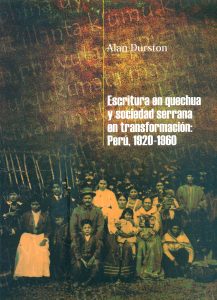Dear Colleagues:
This department's output comes in many languages, and our co lleague, Alan Durston has just produced a new book in Spanish. Below please find the translated summary of the book, and the table of contents in Spanish. Please join me in congratulating Alan on his new publication.
lleague, Alan Durston has just produced a new book in Spanish. Below please find the translated summary of the book, and the table of contents in Spanish. Please join me in congratulating Alan on his new publication.
Thabit
________________________

Escritura en quechua y sociedad serrana en transformación: Perú, 1920-1960. Instituto Francés de Estudios Andinos and Instituto de Estudios Peruanos (Lima, Peru), 2019 (132p).
Translation of blurb:
Between 1920 and 1960 there was a Quechua literary boom in Peru characterized by the emergence of new genres - such as "costumbrista" theater, in which contemporary rural life was portrayed - and by regionalist inspirations. The authors were bilinguals who belonged to the professional class of urban centers of the southern Peruvian highlands where Quechua still predominated, such as Cusco and Ayacucho. This book examines the contexts and functions of writing in Quechua during a time of great transformations through three case studies: Moisés Cavero Cazo (Ayacucho), Andrés Alencastre (Cusco) and Teodoro Meneses Morales (Huanta). What inspired them to write theater, poetry, and prose in Quechua? By examining this corpus and placing it in its historical context, this book seeks to contribute to the historiography on cultural change in the modern southern Peruvian highlands, as well as the history of Quechua as a written language.
Table of Contents:
– Agradecimientos
– Notas del autor
– Introducción
– Capítulo 1. Contextos locales y nacionales de la escritura en quechua
– Capítulo 2. Moisés Cavero Cazo y el cultivo del quechua huamanguino
– Capítulo 3. Andrés Alencastre: del neoindianismo al incaísmo
– Capítulo 4. Teodoro Meneses Morales y el Grupo Huanta
– Capítulo 5. Ortografía y literacidad
– Conclusiones
– Bibliografía
